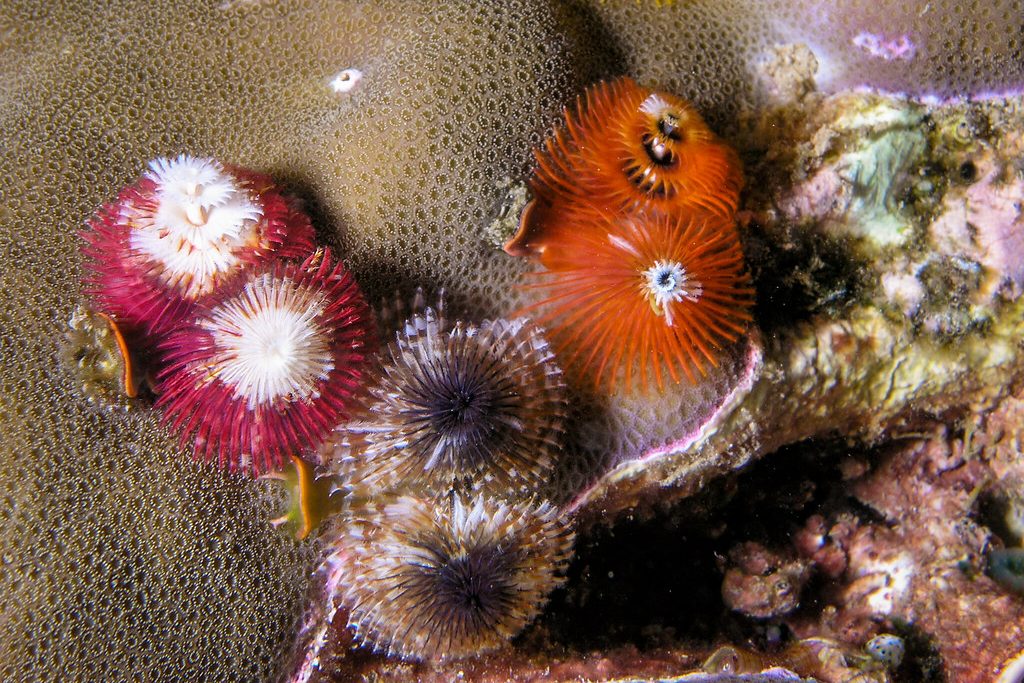Today, I want to introduce a fascinating group of worms that are particularly relevant during the Christmas season. Known as Christmas tree worms, these marine annelids belong to the family Serpulidae. They are renowned for their radiolar crowns and their habit of dwelling within calcareous tubes attached on surfaces.

You might find it interesting that serpulids, along with sabellids, are often referred to as “sea flowers” due to their colorful crowns. The crown consists of a pair of radioles, and in most serpulids, one of the radioles has evolved into an operculum. This operculum serves as a protective tube plug when the worm withdraws into the tube. The shape of the operculum is species-specific but generally follows a pattern within each genus.
“Christmas tree worms” are the most conspicuous group within the genus Spirobranchus. This genus name, derived from their spiral-shaped, gill-like feeding appendages, combines the Latin spira (spiral) and Greek branchia (gills). The radioles may be arranged in a clear spiral of one to eight whorls. Naturally, those with only one whorl do not resemble a Christmas tree. While there are species from different genera like Protula bispiralis that can have multi-whorled radioles, it is the Spirobranchus species that truly resemble a Christmas tree when their radioles are fully extended.

With more than 30 species within the genus, all genetically studied Christmas tree worm, encompassing five nominal species, were found to belong to a monophyletic clade (see Perry et al. 2018). It was previously believed that all Christmas tree worms live in association with live corals and less frequently on artificial substrates. However, based on my personal observations, one species, S. aloni, characterized with four spirals, can be found on a variety of substrates, including different coral species, natural substrata, and artificial materials. This species appears to exhibit substantial abundance on natural and artificial substrata rather than on corals.
The size of serpulids is usually small as it can be less than 2mm, but some, including those in our group of interest, can exceed 10 cm. If you have the opportunity to snorkel or dive in shallow, warm waters, look for feather-like structures attached to corals and surrounding substrates, dancing in the water flow.

Christmas tree worms are particularly noticeable due to their multicolored crowns. Their colors can vary not only between individuals but also along the length of their spiral structures. It is not uncommon to see a single worm displaying different colors along its lobes, making each one uniquely beautiful, much like snowflakes.

Most species of this genus inhabit subtropical and tropical waters. However, the North Atlantic temperate species S. triqueter has extended its range into Arctic waters, thanks to the warm Atlantic Gulf Stream current. Although S. triqueter has only one whorl, we can still take comfort in knowing that this relative of the Christmas tree worms celebrates Christmas with us in Norway.

- Photos from https://www.flickr.com/ and https://www.artsdatabanken.no/
- Perry, O., Bronstein, O., Simon-Blecher, N., Atkins, A., Kupriyanova, E., ten Hove, H., … & Fine, M. (2018). On the genus Spirobranchus (Annelida, Serpulidae) from the northern Red Sea, and a description of a new species. Invertebrate Systematics, 32(3), 605-626.
![]()